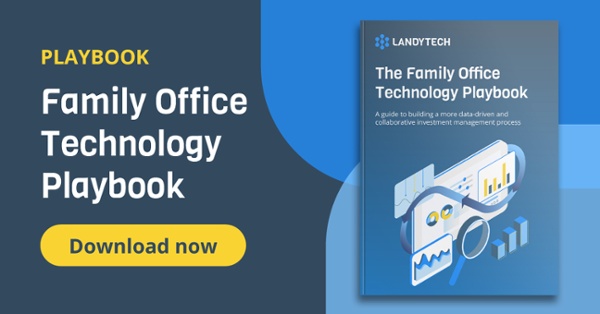Written by Landytech
8 Jan 2024
To say the current economic environment is complex would be an understatement. With interest rates high and structural economic headwinds persisting, many economists believe we are in a “rolling recession” — a slow-growth period with industries contracting at different times.
In a less than certain world, it is not just economic headwinds family offices are having to contend with, as they grapple with a diverse range of issues from operational challenges to governance and succession planning. Here, technology, especially advanced family office investment management platforms, plays a pivotal role in navigating these challenges.
Against this backdrop, what does the future hold for family offices in 2024?
1. Shifting asset allocations
Amid resilient financial markets and unrealised fears of recession in 2023, there has been a notable shift in family office asset allocations. According to Citi Bank’s Global Family Office Survey 2023, over half of respondents had increased allocations to high-quality short-duration fixed income, with 38% allocating more to private equity.
This trend reflects a strategic shift towards more defensive investment postures, balancing risk with potential growth opportunities. Although concerns persist around inflation, interest rate increases and geopolitical tensions, most portfolio values rebounded in 2023 and nearly all respondents expected positive portfolio returns over the next twelve months.
2. Advancing professionalisation of the investment function
2023 saw many family offices continue in the professionalisation of the investment function. Over two-thirds now report to have an investment committee as part of their governance structure and over half have an investment policy statement (IPS).
Despite the progress in these areas, many still use Excel for consolidated reporting, with less than half reporting to use 3rd party software for consolidated reporting. This indicates a significant opportunity for further digital transformation in investment reporting and analysis.
As portfolios continue to grow in complexity and span multiple asset classes, currencies, geographies, through a variety of ownership structures, it is more important than ever that family offices have a platform capable of aggregating this data for a complete overview of wealth.
3. Closing the governance gap
The primary objective of family offices is to support the safeguarding of family wealth both for present and future generations, but many are still yet to put the necessary governance and risk management frameworks in place to fulfil that purpose. According to the UBS Global Family Office Report 2023, less than half of respondents had a wealth succession plan for family members, with a similar percentage having no documented governance framework.
This gap presents a critical area for improvement, particularly in establishing clear, documented procedures for wealth management and succession. As the professionalisation of the investment function continues, there are a growing number of family offices implementing a risk management framework as part of the investment decision making process.
Family offices now want access to institutional-grade risk systems to manage hidden risk hotspots and underlying portfolio risk drivers. Capabilities such as stress-testing, VaR and liquidity analysis, once considered the preserve of asset managers and hedge funds, are now much more commonplace in family office investment analysis.
4. Diversifying across private markets
The popularity of private equity has surged in recent years, but across 2023 and heading into 2024, there has been a shift away from direct private equity allocations towards private equity funds, private debt and infrastructure. However, there has been no let-up in the popularity of illiquid asset classes, as family offices still see it as a way to access growth investments in sectors such as technology.
This diversification is not just a trend but a strategic approach to balance risk and return in an increasingly complex market environment. But the continued popularity of private investments presents a significant analytical and reporting challenge for family offices. Non-custodied private asset data is typically stored in a variety of documents, reports and spreadsheets, needing to be inputted manually into reporting systems. This makes performance monitoring and consolidated reporting with public investments a time-consuming and laborious task.
5. Growing room for allocations in sustainable investing
Across 2023, there was a considerable re-evaluation among family offices of how to invest sustainably. Debate remains about how to define sustainable investments and how to assess their contribution to social and environmental impact. It means the gap between interest and action in sustainable investments remains significant.
However, this evolving landscape of sustainable investing offers an opportunity for family offices to lead in defining and adopting best practices. Although more than half of family offices now have allocations in sustainable investments as sustainability concerns grow, many are awaiting investment opportunities with more competitive financial performance before making additional allocations.
6. Escalating threat of cyberattacks
The threat of a cyberattack is a very real concern for family offices, posing a critical risk to the business. To keep family information and assets safe there has been a growing trend towards better privacy safeguards, securing access on a need-to-know basis.
This necessitates a robust, multi-layered cybersecurity strategy, incorporating both technological solutions and employee training. Firms are turning towards hosting data on the cloud instead of server-based systems and hard copy documents, to ensure that all data is secure and protected from a cyber-attack. Cloud-based software solutions employ security measures beyond the affordability of most businesses.
7. Persistent staffing challenges
Family offices are finding that it is increasingly difficult to attract and retain top talent. In a competitive job market, they're having to pay more out in salaries and bonuses, as demand continues to outpace supply.
With competition for staff hotter than ever, staff turnover is a greater consideration than in previous years. The threat of key person risk looms large – where staff complete manual tasks and become familiar with the intricacies of reporting spreadsheets, pockets of expertise develop which can leave others in the team in the dark if the expert leaves.
By adopting the latest technology platforms and automating burdensome data management and reporting tasks, family offices find it easier to attract top talent and reduce key person risk, with staff instead able to focus on higher-value portfolio management and analysis work.
8. Stubbornly high operating costs
With inflation recently beginning to fall from multi-decade highs, family offices are spending elevated amounts on staff, systems, and cybersecurity. To counteract these rising costs, family offices are placing their focus on core investment management and wealth management activities.
This strategic focus aims to streamline operations and enhance efficiency, ultimately driving cost-effectiveness. This increasingly means looking for third-party providers to automate or outsource non-core functions, reducing costs and harnessing the economies of scale these providers enable. There has been a trend towards family offices harnessing technology platforms to automate data management and reporting processes to free up staff time and save on overheads.
9. Evolving strategies for succession planning
The great wealth transfer is well underway, and it is important that family offices put in place strategies that ensure that the next generation is equipped to take on the responsibility of family wealth. This includes not only wealth management education but also fostering strong family values and a sense of stewardship among the younger generation.
Family offices can play a crucial role in preparing for wealth transition. It can be a significant challenge for UHNW families as the risk of wealth dilution increases when it’s transferred to numerous children or other family members. Next-generation family members may have limited knowledge about investing and wealth preservation, so it’s important that family offices spend time educating them in preparation for wealth transition. Establishing strong personal relationships with these family members can also support them through this period of change.
10. Increasing adoption of technology solutions
In today’s uncertain world, family offices are facing pressures from multiple directions. The need to gather and report on an abundance of data across increasingly diversified asset classes. The need to build defences against cyberattacks. And the need to build governance and risk management frameworks to secure family wealth for generations to come.
But despite such uncertainty, one thing is for sure. As family portfolios become more complex and efforts to increase transparency and collaboration among stakeholders grow, the need for a technology platform from which to manage complex, multi-generational wealth becomes more pressing.
Find out how family offices can use technology to solve their biggest data management and reporting challenges in our latest whitepaper.
Related Content

How your family office should be sourcing wealth data
As today’s UHNW become more geographically dispersed and family officesbecome more sophisticated in their investment functions and allocation strategies,portfoliosnowconsist of multiple asset classes, custodians and currencies, and investments...
-1.jpg)
5 ways to improve productivity in your family office
As family offices attempt to modernise, many are facing productivity challenges due to out-of-date, disparate internal systems andheavily manual processes. Naturally, there are inherent risks associated with such inefficiencies, including missed ...
/Blog%20and%20content%20images/Private-Asset-Reporting-Blog_v01.jpg)
The Top 5 Alternative Investment Reporting Challenges for Family Offices
For many years, alternative investments including private equity, hedge funds, real estate were seen as nothing but satellite allocations in the portfolios of asset owners. This made the job of family offices comparatively simpler when it came to...



